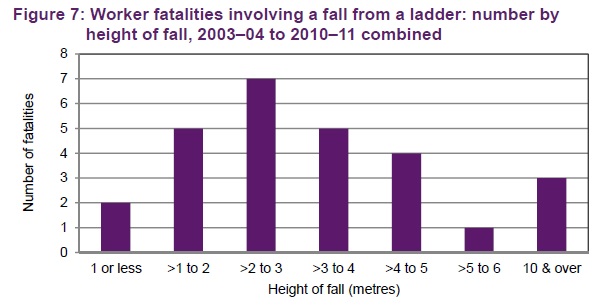Most falls from ladders occur from heights of 10 feet or less. Surprisingly, these falls can cause serious injuries or even death.
Ladders are common tools in many homes and workplaces. They help us reach high places, but they also pose risks. Many people assume that only high falls are dangerous. However, most accidents happen from shorter heights. This fact highlights the importance of ladder safety at all times.
Understanding the risks and knowing how to use a ladder properly can prevent accidents. In this blog, we will explore the common heights from which ladder falls occur. We will also discuss the reasons behind these accidents and provide tips for safer ladder use. Stay safe and informed.

Credit: blogs.cdc.gov
Common Ladder Heights
Understanding common ladder heights helps in choosing the right ladder for any task. It’s essential to know the heights where most falls occur to ensure safety. Most falls from ladders happen between 6 and 10 feet. Knowing this can help in taking extra precautions at these heights.
Typical Usage Heights
Ladders come in various heights, and each height has a typical use. Here is a breakdown:
| Height | Typical Use |
|---|---|
| 6 feet | Indoor tasks like painting or light bulb replacement |
| 8 feet | Reaching higher shelves or outdoor small repairs |
| 10 feet | Cleaning gutters or accessing roof edges |
| 12 feet | Tree trimming or high ceiling work |
Popular Ladder Types
Different ladder types are used for different heights. Some popular types include:
- Step Ladders: Best for indoor use and small jobs. Typically 4 to 8 feet tall.
- Extension Ladders: Ideal for reaching higher places. Can extend up to 24 feet or more.
- Multi-purpose Ladders: Versatile and adjustable. Can be used for various tasks at different heights.
- Telescoping Ladders: Compact and easy to store. Extendable to various heights, usually up to 16 feet.
Choosing the right ladder type and height is critical for safety. Be mindful of the height you are working at. Most falls occur between 6 and 10 feet. Always take precautions to avoid accidents.

Credit: www.erectastep.com
Shocking Statistics
Falls from ladders are a common cause of injuries and fatalities. Understanding the heights at which most falls occur can help improve safety measures. Let’s dive into some shocking statistics that reveal the true risks associated with ladder use.
Injury Rates
According to recent data, most ladder-related injuries occur from heights between 6 to 10 feet. These falls often result in serious injuries.
- 55% of falls from ladders happen at heights less than 10 feet.
- Common injuries include fractures, sprains, and head injuries.
- Workers in construction and maintenance are at higher risk.
Even a fall from a seemingly low height can cause severe harm. Proper safety protocols are essential.
Fatality Rates
Fatal falls are less frequent but still significant. Most fatal ladder falls occur from heights over 20 feet.
| Height | Percentage of Fatal Falls |
|---|---|
| 0-5 feet | 5% |
| 6-10 feet | 10% |
| 11-20 feet | 25% |
| Over 20 feet | 60% |
Most fatal falls occur from heights over 20 feet. These accidents often lead to death due to the impact of the fall.
Safety equipment and proper ladder use can prevent these tragic accidents.
Risk Factors
Understanding the risk factors associated with falls from ladders can save lives. Most falls occur from a height of less than 10 feet. This highlights the importance of safe ladder practices. Let’s explore the key risk factors below.
Improper Usage
Improper usage is a major risk factor for ladder falls. Many people use ladders incorrectly. They might not follow the safety guidelines. This increases the chances of an accident.
- Overreaching or leaning too far to one side.
- Using a ladder that is too short for the task.
- Not maintaining three points of contact while climbing.
Each of these mistakes can lead to a fall. Always use the ladder as intended. This can greatly reduce the risk of an accident.
Environmental Conditions
Environmental conditions also play a significant role in ladder falls. Working in unsuitable conditions can be very dangerous.
| Condition | Risk Factor |
|---|---|
| Wet or slippery surfaces | Increased likelihood of slipping |
| Uneven ground | Ladder instability |
| Strong winds | Difficulty in maintaining balance |
Ensure the environment is safe before using a ladder. This can significantly reduce the risk of a fall.

Credit: prochoicesafetygear.com
Safety Measures
Falling from ladders often leads to serious injuries. Many falls happen from a height of 10 feet or less. Implementing proper safety measures can reduce risks. Here are some essential tips.
Proper Setup
Setting up a ladder correctly is crucial. Follow these steps:
- Ensure the ladder is on a flat, stable surface.
- Keep the ladder at a 75-degree angle.
- Extend the ladder three feet above the roofline if climbing onto a roof.
- Lock the spreader bars on step ladders.
Inspect the ladder for damage. Avoid using a damaged ladder. Always use a ladder suitable for the task.
Using Safety Gear
Safety gear can prevent many injuries. Consider the following:
- Helmet: Protects your head in case of a fall.
- Non-slip shoes: Provide better grip.
- Harness: Essential for working at heights above 10 feet.
Always wear a helmet and non-slip shoes. Use a harness when necessary. Safety gear is your first line of defense.
Impact Of Falls
Falls from ladders can have serious consequences. Understanding the impact of falls is crucial for prevention.
Physical Injuries
Falls from ladders often lead to severe physical injuries. Many injuries occur from heights of 6 to 10 feet. Common injuries include:
- Broken bones
- Sprains
- Head trauma
- Back injuries
These injuries can require long recovery times. They may also lead to chronic pain or disability.
Economic Costs
Falls from ladders also have significant economic costs. These costs affect both individuals and businesses. Key costs include:
| Cost Type | Details |
|---|---|
| Medical Expenses | Hospital bills, surgery, rehabilitation |
| Lost Wages | Time off work due to injury |
| Productivity Loss | Reduced workforce efficiency |
| Insurance Premiums | Increased premiums for businesses |
These costs can add up quickly. Preventing falls can save money and improve safety.
Frequently Asked Questions
What Height Do Most Ladder Falls Occur From?
Most ladder falls occur from heights between 6 to 10 feet. This height is common for household tasks.
Why Do People Fall From Ladders?
People fall from ladders due to improper use, overreaching, or unstable surfaces. Lack of proper footing is also a cause.
How Can Ladder Falls Be Prevented?
Ladder falls can be prevented by using stable surfaces, not overreaching, and following safety instructions. Always secure the ladder.
What Injuries Are Common From Ladder Falls?
Common injuries from ladder falls include fractures, sprains, and head injuries. These injuries can be serious and require medical attention.
Are Certain Types Of Ladders Safer?
Yes, some ladders are safer. For example, ladders with non-slip steps and sturdy construction reduce the risk of falls.
What Should You Do If You Fall From A Ladder?
If you fall from a ladder, seek medical help immediately. Avoid moving if you feel severe pain or suspect serious injury.
Conclusion
Falls from ladders mostly occur from heights of 10 feet or less. Understanding ladder safety can save lives. Always follow safety guidelines. Use sturdy ladders and secure them properly. Avoid reaching too far while on a ladder. Stay mindful of your surroundings.
Ensure the ladder is on stable ground. Wear proper footwear to avoid slipping. Regularly check your ladder for damage. Always prioritize safety over speed. Stay safe and prevent falls.
Recent Posts
Maintaining clean gutters is essential for preventing water damage to your home, and choosing the best ladder for cleaning gutters can make the job much easier and safer. With so many options on the...
Best Ladder for Cleaning Caravan Roof: Top Picks for You Every Adventure!
Today we will discuss the best ladder for cleaning caravan roof. Cleaning caravan roofs is one of the crucial tasks.After many days, a caravan roof can get dirty by debris, dirt, and grime. These can...
